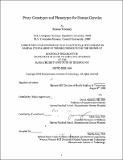Proxy genotypes and phenotypes for human genetics
Author(s)
Yelensky, Roman
DownloadFull printable version (23.20Mb)
Other Contributors
Harvard University--MIT Division of Health Sciences and Technology.
Advisor
David Altshuler and Mark Daly.
Terms of use
Metadata
Show full item recordAbstract
Genetic mapping by association is an unbiased approach to discover genes and pathways influencing disease traits and response to drugs and environmental exposures. There are two key obstacles to mapping in humans: (1) The full sequence of study subjects cannot yet be obtained; and (2) There are substantial limits to the phenotypes that can be safely elicited or measured. Geneticists thus rely on practically measurable sets of genotypes to proxy for the sequence and human in-vitro models that proxy for in-vivo genetics and physiology while allowing for perturbation and characterization in high throughput. This thesis presents the development of one important class of proxy genotypes, those that capture most common genetic variation, as well as an evaluation and refinement of proxy phenotypes offered by one commonly used in-vitro model, the lymphoblastoid cell-line.Capturing common human genetic variation for genome-wide association studies requires genotyping a feasible subset of proxy (or "tag") SNPs. We investigated selection and analysis of tag SNPs, examined the relationship between investment in genotyping and statistical power, and evaluated whether power is compromised when tags are selected from an incomplete resource such as HapMap. We demonstrate an efficient haplotypebased tagging approach and other methods that dramatically increase tagging efficiency. Examining all observed haplotypes for association increases power to detect rare causal alleles, while reducing power for common alleles. Power is robust to completeness of the reference panel and holds across demographically related groups.Lymphoblastoid cell lines (LCLs) are being developed into an in-vitro model where genetics of human gene expression, drug response, and other traits can be studied under controlled conditions. However, the impact of the immortalization process, the relative influence of non-genetic factors, and reproducibility of measured traits are not yet understood. (cont.) We addressed these questions while mapping loci for response to chemotherapy and found that traits in LCLs are subject to substantial confounders and are only modestly reproducible in independent experiments. Despite this, RNA expression of many genes is affected by genetic variation and predicts response to drugs; integrating SNPs, RNA, and drug response can identify novel pharmacogenetic variation mediated by RNA.
Description
Thesis (Ph. D.)--Harvard-MIT Division of Health Sciences and Technology, 2008. Includes bibliographical references.
Date issued
2008Department
Harvard University--MIT Division of Health Sciences and TechnologyPublisher
Massachusetts Institute of Technology
Keywords
Harvard University--MIT Division of Health Sciences and Technology.